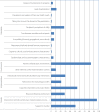Effective surveillance systems for vector-borne diseases in urban settings and translation of the data into action: a scoping review
- PMID: 30217142
- PMCID: PMC6137924
- DOI: 10.1186/s40249-018-0473-9
Effective surveillance systems for vector-borne diseases in urban settings and translation of the data into action: a scoping review
Abstract
Background: Vector-borne diseases (VBDs) continue to represent a global threat, with "old" diseases like malaria, and "emergent" or "re-emergent" ones like Zika, because of an increase in international trade, demographic growth, and rapid urbanization. In this era of globalization, surveillance is a key element in controlling VBDs in urban settings, but surveillance alone cannot solve the problem. A review of experiences is of interest to examine other solution elements. The objectives were to assess the different means of VBD surveillance in urban environments, to evaluate their potential for supporting public health actions, and to describe the tools used for public health actions, the constraints they face, and the research and health action gaps to be filled.
Main body: For this scoping review we searched peer-reviewed articles and grey literature published between 2000 and 2016. Various tools were used for data coding and extraction. A quality assessment was done for each study reviewed, and descriptive characteristics and data on implementation process and transferability were analyzed in all studies. After screening 414 full-text articles, we retained a total of 79 articles for review. The main targets of the articles were arboviral diseases (65.8%) and malaria (16.5%). The positive aspects of many studies fit within the framework of integrated vector management. Public awareness is considered a key to successful vector control programs. Advocacy and legislation can reinforce both empowerment and capacity building. These can be achieved by collaboration within the health sector and with other sectors. Research is needed to develop well designed studies and new tools for surveillance and control.
Conclusions: The need for surveillance systems in urban settings in both developing and developed countries was highlighted. Countries face the same challenges relating to human, financial, and structural resources. These findings also constitute a wake-up call for governments, academia, funders, and World Health Organization to strengthen control programs and enhance VBD research in urban environments.
Keywords: Scoping review; Surveillance systems; Urban health; Vector-borne diseases.
Conflict of interest statement
Ethics approval and consent to participate
Not applicable.
Consent for publication
Not applicable.
Competing interests
The authors declare that they have no competing interests.
Figures







Similar articles
-
Scoping review on vector-borne diseases in urban areas: transmission dynamics, vectorial capacity and co-infection.Infect Dis Poverty. 2018 Sep 3;7(1):90. doi: 10.1186/s40249-018-0475-7. Infect Dis Poverty. 2018. PMID: 30173661 Free PMC article.
-
Interventions for vector-borne diseases focused on housing and hygiene in urban areas: a scoping review.Infect Dis Poverty. 2018 Sep 3;7(1):96. doi: 10.1186/s40249-018-0477-5. Infect Dis Poverty. 2018. PMID: 30173670 Free PMC article.
-
Containment measures for emerging and re-emerging vector-borne and other infectious diseases of poverty in urban settings: a scoping review.Infect Dis Poverty. 2018 Sep 3;7(1):95. doi: 10.1186/s40249-018-0478-4. Infect Dis Poverty. 2018. PMID: 30173673 Free PMC article.
-
Impact, economic evaluation, and sustainability of integrated vector management in urban settings to prevent vector-borne diseases: a scoping review.Infect Dis Poverty. 2018 Sep 3;7(1):83. doi: 10.1186/s40249-018-0464-x. Infect Dis Poverty. 2018. PMID: 30173675 Free PMC article.
-
Beyond the black stump: rapid reviews of health research issues affecting regional, rural and remote Australia.Med J Aust. 2020 Dec;213 Suppl 11:S3-S32.e1. doi: 10.5694/mja2.50881. Med J Aust. 2020. PMID: 33314144
Cited by
-
Behaviour and distribution of Aedes aegypti mosquitoes and their relation to dengue incidence in two transmission hotspots in coastal Ecuador.PLoS Negl Trop Dis. 2024 Apr 29;18(4):e0010932. doi: 10.1371/journal.pntd.0010932. eCollection 2024 Apr. PLoS Negl Trop Dis. 2024. PMID: 38683840 Free PMC article.
-
Establishing research priorities in prevention and control of vector-borne diseases in urban areas: a collaborative process.Infect Dis Poverty. 2018 Sep 3;7(1):85. doi: 10.1186/s40249-018-0463-y. Infect Dis Poverty. 2018. PMID: 30173663 Free PMC article.
-
Identifying urban hotspots of dengue, chikungunya, and Zika transmission in Mexico to support risk stratification efforts: a spatial analysis.Lancet Planet Health. 2021 May;5(5):e277-e285. doi: 10.1016/S2542-5196(21)00030-9. Lancet Planet Health. 2021. PMID: 33964237 Free PMC article.
-
One Health, many approaches: integrated vector management strategies support One Health goals.Front Insect Sci. 2025 Jun 3;5:1549348. doi: 10.3389/finsc.2025.1549348. eCollection 2025. Front Insect Sci. 2025. PMID: 40530168 Free PMC article. Review.
-
Vector-borne infectious diseases in pregnancy in the era of climate change: A focus on mosquito- and tick-borne pathogens (Review).Exp Ther Med. 2025 Jul 21;30(3):174. doi: 10.3892/etm.2025.12924. eCollection 2025 Sep. Exp Ther Med. 2025. PMID: 40746445 Free PMC article. Review.
References
-
- WHO. Vector-borne disease. Geneva: World Health Organization; 2017. http://www.who.int/mediacentre/factsheets/fs387/en/. Accessed 13 July 2017.
-
- WHO. Hidden cities: unmasking and overcoming health inequities in urban settings. Kobe: World Health Organization, The WHO Centre for Health Development; 2010.
Publication types
MeSH terms
LinkOut - more resources
Full Text Sources
Other Literature Sources
Miscellaneous

